
How to Add Smart Home Features to Your Rental Property
ebook include PDF & Audio bundle (Micro Guide)
$12.99$9.99
Limited Time Offer! Order within the next:

In recent years, smart home technology has rapidly evolved, offering homeowners and tenants alike a range of devices and systems that increase comfort, convenience, and security. For rental property owners, adding smart home features to a property can boost its appeal, enhance tenant satisfaction, and even increase the property's market value. However, incorporating smart technologies into a rental home comes with its own unique challenges and considerations, such as costs, installation processes, and tenant privacy concerns.
In this article, we will explore the benefits and challenges of adding smart home features to your rental property, how to choose the right smart devices, and the practical steps for integrating these technologies without overstepping boundaries. Whether you're a landlord or a tenant looking to make your living space more tech-savvy, this guide will provide a detailed roadmap for navigating the world of smart home technology in rental properties.
The Rise of Smart Homes: A Growing Trend in the Rental Market
Before diving into the specifics of adding smart home features to a rental property, it's essential to understand why these technologies are gaining traction, especially in the context of rentals. A smart home is typically equipped with devices that can be controlled remotely through smartphones, voice commands, or automated systems. These devices can range from lighting and climate control to security cameras, door locks, and even appliances.
The Appeal of Smart Homes for Tenants
Tenants are increasingly looking for convenience and automation in their living spaces. Smart home devices allow them to control various aspects of their environment, from adjusting the thermostat while they're on the way home to managing lighting settings for security purposes. The ability to integrate these features into a rental property not only enhances their quality of life but also makes their living space feel modern and in line with current technological trends.
The Benefits for Landlords
For landlords, smart home technology can be an attractive selling point, especially in a competitive rental market. Smart devices can help streamline property management by offering remote monitoring and control, thus reducing maintenance costs and improving security. Features like smart thermostats, for example, can help lower utility costs, which may benefit both the landlord and the tenant. Additionally, adding smart devices can increase property value and make it more appealing to prospective renters who prioritize technology.
Key Smart Home Features to Consider for Your Rental Property
When considering smart home features for your rental property, it's crucial to think about both the needs of the tenants and the potential benefits to the property owner. Below, we'll discuss several key categories of smart devices that can be added to a rental property.
1. Smart Thermostats
A smart thermostat allows tenants to control the temperature in their rental home remotely via a smartphone or voice assistant. These devices can learn a tenant's habits and automatically adjust the temperature based on their preferences, which can lead to energy savings. For landlords, this means potentially lower heating and cooling costs, especially in larger homes.
Popular Options:
- Nest Thermostat: Known for its sleek design and energy-saving features.
- Ecobee SmartThermostat: Offers room sensors to improve comfort and efficiency.
2. Smart Lighting
Smart lighting systems allow tenants to control lights remotely and set schedules. These lights can be customized to fit any lifestyle, from brightening a room when entering to dimming them for an evening ambiance. With smart bulbs, tenants can adjust light color and brightness, adding an extra layer of convenience and energy efficiency. Additionally, smart lighting systems can be controlled using voice commands through smart assistants like Amazon Alexa or Google Assistant.
Benefits for Landlords:
- Energy Savings: Automatically turning off lights when no one is in the room helps lower energy bills.
- Increased Security: Setting up lighting schedules or remote control can simulate occupancy, reducing the likelihood of break-ins.
Popular Options:
- Philips Hue: Offers a wide range of smart bulbs, lamps, and light strips with customizable colors.
- LIFX: Known for vibrant colors and easy-to-use app controls.
3. Smart Locks
Smart locks provide a keyless entry solution and enhance the security of a rental property. These locks allow tenants to access the property through their smartphones, key codes, or even biometric data. Smart locks also offer landlords the ability to remotely grant or revoke access to the property, which is useful for managing multiple rental units or handling emergencies.
Benefits for Landlords:
- Remote Access: Landlords can provide temporary access codes to maintenance staff or emergency personnel.
- Improved Security: Reduced risk of lost or copied keys.
Popular Options:
- August Smart Lock: Allows users to retain their existing keys while providing smart access features.
- Schlage Encode: A secure, Wi-Fi-enabled lock that doesn't require a hub.
4. Smart Security Systems
A robust security system is one of the most important features for any rental property. Smart security devices allow tenants and landlords to monitor and protect their property from anywhere. These systems typically include cameras, motion sensors, door/window sensors, and even smart doorbells. Integration with apps allows for instant alerts and video feeds, enhancing security and peace of mind.
Benefits for Landlords:
- Enhanced Property Protection: Monitor the property remotely to ensure it remains secure.
- Reduced Vandalism and Theft: Surveillance cameras act as a deterrent to potential burglars or vandals.
Popular Options:
- Ring Video Doorbell: Provides video feeds and two-way audio for real-time communication.
- SimpliSafe: Offers customizable home security systems with no long-term contracts.
5. Smart Appliances
Smart appliances, such as refrigerators, washing machines, and dishwashers, are becoming increasingly popular in rental properties. These devices are designed to be more energy-efficient and offer enhanced convenience through remote control. For example, a smart refrigerator can track expiration dates, while a smart washer can send alerts when a laundry cycle is complete.
Benefits for Landlords:
- Efficiency: Smart appliances often consume less energy, which can result in lower utility costs.
- Tenant Satisfaction: Modern appliances appeal to tenants who value convenience and innovation.
Popular Options:
- Samsung Smart Fridges: Offer features like internal cameras and touchscreens for managing groceries.
- Whirlpool Smart Washers: Can be controlled via app to start, pause, or monitor wash cycles.
6. Smart Smoke Detectors and Carbon Monoxide Detectors
Safety is a priority in any rental property. Smart smoke and carbon monoxide detectors offer real-time alerts to both tenants and landlords if smoke or dangerous gas levels are detected. These devices can send notifications to smartphones, allowing for quicker responses in case of an emergency.
Benefits for Landlords:
- Instant Alerts: Receive notifications in case of emergencies, ensuring prompt action.
- Peace of Mind: Tenants can rest assured that their safety is being monitored even when they are not at home.
Popular Options:
- Nest Protect: Offers smoke and carbon monoxide detection with voice alerts.
- First Alert Onelink Safe & Sound: Combines smoke and CO detection with built-in speakers for alerts and music.
7. Smart Plugs and Switches
Smart plugs and switches can turn standard appliances or lights into smart devices. These plugs can be controlled remotely via an app, and they can be programmed to turn on and off at specific times. This is a low-cost way to introduce smart technology to a rental property without needing to replace existing fixtures.
Benefits for Landlords:
- Cost-Effective: Inexpensive solution to adding smart capabilities to non-smart appliances.
- Energy Efficiency: Schedule devices to turn off when not in use, reducing energy consumption.
Popular Options:
- TP-Link Kasa Smart Plug: Affordable and easy to use.
- Wemo Mini Smart Plug: Compact and works with voice assistants like Alexa and Google Assistant.
Steps for Adding Smart Home Features to Your Rental Property
Adding smart home features to a rental property can seem like a daunting task, especially if you are unfamiliar with the technology. However, with careful planning, the process can be seamless and straightforward. Below, we outline a step-by-step guide to help you integrate smart technology into your rental property.
Step 1: Identify Tenant Needs and Preferences
Before purchasing any devices, it's important to assess the needs and preferences of your tenants. While smart home technology can be a major selling point, it's essential to ensure that the devices you choose will add value to the living experience. Some tenants may prefer basic features like smart locks or thermostats, while others may want fully automated lighting or a comprehensive security system.
Step 2: Choose Smart Devices That Are Easy to Install
When selecting smart devices, it's important to consider ease of installation. For rental properties, tenants and landlords alike will appreciate devices that don't require complex wiring or modifications to the property. Many smart home devices are plug-and-play, meaning they can be set up without professional assistance.
Step 3: Consider Privacy and Security Concerns
As you add smart devices to your rental property, be mindful of privacy and security concerns. Some smart home devices, such as cameras or smart doorbells, may raise privacy issues among tenants. It's important to communicate with tenants about what devices will be installed and ensure that their privacy is respected. Always seek consent from your tenants before installing surveillance devices or cameras.
Step 4: Install Devices and Test Their Functionality
Once you've selected the appropriate smart devices for your rental property, it's time to install them. Many smart devices come with detailed instructions, making installation a straightforward process. After installation, thoroughly test each device to ensure that it functions properly and that tenants are able to use it without difficulty.
Step 5: Educate Tenants on How to Use the Devices
Once the smart devices are installed, take the time to educate your tenants on how to use them. Provide them with user manuals or guides that outline how to operate the devices, set up schedules, and troubleshoot common issues. Ensuring that tenants understand how to use the devices will increase satisfaction and prevent misunderstandings.
Step 6: Maintain and Update Devices
Smart devices require regular updates and maintenance to function optimally. As a landlord, you should ensure that your smart devices are kept up to date with the latest firmware and security patches. Schedule periodic checks to ensure that all devices are working correctly and that tenants are satisfied with their performance.
Conclusion
Integrating smart home features into your rental property offers numerous benefits for both tenants and landlords, from enhanced convenience and security to energy savings and increased property value. By carefully selecting and installing the right smart devices, landlords can enhance the appeal of their rental properties and provide tenants with a modern, comfortable living experience. Whether you are looking to improve security, reduce energy costs, or simply offer a more tech-savvy living space, the addition of smart home features can transform a standard rental into a highly sought-after property in today's competitive rental market.

How to Create a Budget for Home Improvement Projects
Read More
How To Deal with Passive Aggression
Read More
How to Invest for Retirement: 401(k) vs. IRA
Read More
How to Soundproof Your Floor from Noisy Neighbors Above
Read More
How to Start Building a Business Investment Portfolio
Read More
10 Fun Games to Teach Financial Literacy
Read MoreOther Products

How to Create a Budget for Home Improvement Projects
Read More
How To Deal with Passive Aggression
Read More
How to Invest for Retirement: 401(k) vs. IRA
Read More
How to Soundproof Your Floor from Noisy Neighbors Above
Read More
How to Start Building a Business Investment Portfolio
Read More